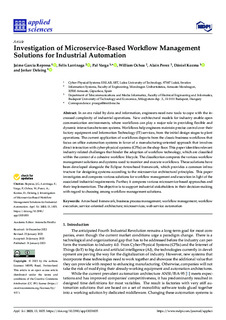| dc.rights.license | Attribution 4.0 International | * |
| dc.contributor.author | Larrinaga, Felix | |
| dc.contributor.author | Ochoa, William | |
| dc.contributor.author | Perez Riaño, Alain | |
| dc.contributor.other | Garcia Represa, Jaime | |
| dc.contributor.other | Varga, Pal | |
| dc.contributor.other | Kozma, Daniel | |
| dc.contributor.other | Delsing, Jerker | |
| dc.date.accessioned | 2023-02-22T15:13:38Z | |
| dc.date.available | 2023-02-22T15:13:38Z | |
| dc.date.issued | 2023 | |
| dc.identifier.issn | 2076-3417 | en |
| dc.identifier.other | https://katalogoa.mondragon.edu/janium-bin/janium_login_opac.pl?find&ficha_no=171443 | en |
| dc.identifier.uri | https://hdl.handle.net/20.500.11984/5993 | |
| dc.description.abstract | In an era ruled by data and information, engineers need new tools to cope with the increased complexity of industrial operations. New architectural models for industry enable open communication environments, where workflows can play a major role in providing flexible and dynamic interactions between systems. Workflows help engineers maintain precise control over their factory equipment and Information Technology (IT) services, from the initial design stages to plant operations. The current application of workflows departs from the classic business workflows that focus on office automation systems in favor of a manufacturing-oriented approach that involves direct interaction with cyber-physical systems (CPSs) on the shop floor. This paper identifies relevant industry-related challenges that hinder the adoption of workflow technology, which are classified within the context of a cohesive workflow lifecycle. The classification compares the various workflow management solutions and systems used to monitor and execute workflows. These solutions have been developed alongside the Eclipse Arrowhead framework, which provides a common infrastructure for designing systems according to the microservice architectural principles. This paper investigates and compares various solutions for workflow management and execution in light of the associated industrial requirements. Further, it compares various microservice-based approaches and their implementation. The objective is to support industrial stakeholders in their decision-making with regard to choosing among workflow management solutions. | en |
| dc.description.sponsorship | Comisión Europea | es |
| dc.language.iso | eng | en |
| dc.publisher | MDPI | en |
| dc.rights | © 2023 The Authors | en |
| dc.rights.uri | http://creativecommons.org/licenses/by/4.0/ | * |
| dc.subject | Arrowhead framework | en |
| dc.subject | business process management | en |
| dc.subject | workflow management | en |
| dc.subject | workflow execution | en |
| dc.subject | service-oriented architecture | en |
| dc.subject | microservices | en |
| dc.subject | web service automation | en |
| dc.title | Investigation of Microservice-Based Workflow Management Solutions for Industrial Automation | en |
| dcterms.accessRights | http://purl.org/coar/access_right/c_abf2 | en |
| dcterms.source | Applied Sciences | en |
| local.contributor.group | Ingeniería del software y sistemas | es |
| local.description.peerreviewed | true | en |
| local.identifier.doi | https://doi.org/10.3390/app13031835 | en |
| local.relation.projectID | info:eu-repo/grantAgreement/EC/H2020/826452/EU/Arrowhead Tools for Engineering of Digitalisation Solutions/Arrowhead Tools | en |
| local.contributor.otherinstitution | https://ror.org/016st3p78 | en |
| local.contributor.otherinstitution | https://ror.org/02w42ss30 | en |
| local.source.details | Vol. 13. N. 3. N. artículo 1835, 2023 | en |
| oaire.format.mimetype | application/pdf | |
| oaire.file | $DSPACE\assetstore | |
| oaire.resourceType | http://purl.org/coar/resource_type/c_6501 | en |
| oaire.version | http://purl.org/coar/version/c_970fb48d4fbd8a85 | en |








